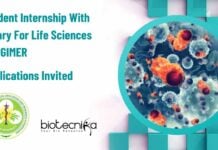NOTES:
Linkage Maps in Inheritance Biology
Hello, everyone. I am Dr. Tanushree, and I welcome you all to today’s session on linkage maps. A topic from CSIR NET unit 8, inheritance biology. This particular topic I have selected for today’s session because this particular topic is very, very important from an exam point of view; every year a question is asked from this particular topic.
Questions are asked both in part B and part C. In part B you will get questions based on gene order. However, in part c, you will get a question not only on Gene order, but along with it they will ask you the distance between the genes.
So when you are preparing for Unit 8, make sure that you don’t skip this particular. Topic. This particular topic is very interesting, very important, and scoring as well. Now, before going in detail about this topic, always start your preparation with the basics first. So to understand this topic, two terms need to be very much clear.
First is Linkage and another is crossing over. So first I will tell you about Linkage.
When we see the structure of a chromosome. It has a centromere, a short arm, that is P arm. And the long arm. That is Q arm and genes are located at different locations on a chromosome. So ABCD, these are the genes which are present at specific locations on a chromosome.
Now, Morgan and his students observed that some pairs of genes. They do not segregate randomly as being proposed by Mendel in his breeding experiments. So Mendel gave certain principles principle of segregation, principle of independent assortment. So Morgan when he performed some experiments, morgan and his students observed that some pair of the genes. They do not segregate randomly, according to Mendel’s principle of independent assortment, but they tend to be inherited together.
So Morgan suggested that these genes were located on the same chromosome. And this is the reason like they are present on the same chromosome and thus they travel together during meiosis. So genes which are located close together on same chromosome and are always inherited together we call them as linked genes. So they travel together during meiosis, arriving at the same destination that is the gametes and are not expected to assort independently which was been proposed by Mendel. So like here you can see these are homologous chromosomes.
Let’s say they have the alleles like two genes. Let’s say we are considering the location of two genes, right? So, as we all know, gene occur. They exist in pairs, where one copy an individual inherit from father, another copy from mother. So here you can see these are the homologous chromosomes, and these two are sister chromatids, and these two are also sister chromatids.
So if there is no crossing over taking place between these genes, then definitely the genes will be inherited together. They travel together during meiosis and you will not find any recombinant progeny. The gametes form will be comprising the parental alleles only. And you will not see any recombinants here. So we can say that linkage between genes is detected as a deviation from expectations, which was based on Mendel’s principle of independent assortment.
Crossing Over
Now, another term, the next term that you have to remember is crossing over. So in the previous slide, I mentioned you about linkage, right? When there is no crossing over taking place. Genes are present on the same chromosome and they are inherited together. So we call them as linked.
The genes are linked. However, genes occasionally switch from one chromosome to another through the process of crossing over. So we can say that genes on the same chromosome, they are like passengers on a charter bus. They travel together and ultimately arrive at the same destination. However, genes occasionally switch from one homologous chromosomes to another through process of crossing over.
As you can see here in this particular diagram. So this blue one and the red one are the homologous chromosome and you can see some crossing over taking place. So crossing over is what exactly? It is the exchange of genetic material during sexual reproduction between two homologous chromosome noncystochromatids that result in recombinant chromosome. So it is one of the final phases of genetic recombination which occurs in patentine stage of propase.
One of meiosis during a process called as synapses so here the genes, they are switching they are switching from one homologous chromosome to another. They are exchanging the genetic material in meiosis one and so you can see these are the recombinant chromosomes like here, some part of red comes on blue we can easily identify identify this crossing over taking place with the help of this color diagram and in meiosis two genes that are normally linked they are sought independently and end up in different gametes So these two terms are very, very important to understand about the genetic maps or the linkage maps, the details of the genetic map and the linkage map. Now, I told you that there is no crossing over when linkage is present, right? Like when the genes are linked. However, it is observed that linkage is rarely complete, that is, crossing.
Some crossing over can take place. So for example, here you can see that if the crossing over is not taking place right when the genes are completely linked, then in that case the chromosomes in the gametes, they have original allele combinations and they are non recombinants. However, if some crossing over takes place, like here, you can see we have four chromatids. So there is a crossing over between non sister chromatids, like two and three. So if these two are exchanging the genetic material, then what will happen?
That they will result into formation of recombinants. So as the first chromatic does not participated in crossing over, fourth also did not participated in crossing over so in this case, we will get non recombinants. The gametes formed here will be non recombinant. However, those chromatids which participate in crossing over, they will form the gametes with the recombinant chromosomes. So we can say that if the crossing over is taking place, half of the resulting gametes will have unchanged chromosome that is non recombinant and half with the recombinant chromosome.
So broadly we can say that the linkage can be complete or incomplete. So the very easy way to remember this particular concept of linkage is that linkage can be complete or incomplete. When complete linkage is there, that means no crossing over and all the parental combinations will get the gametes form will be with the parental alleles, only there will be no recombinants. However, in case of incomplete linkage, yes, the crossing over will be there, some crossing over will be there and we will get the recombinant as well. The gametes form will be having the recombinant, they will have the recombinant chromosomes.
So incomplete linkage where you can see new combination of the traits to be observed. Now, you might be thinking that even the new traits we observe in case of independent assortment as well, like, if you recall, here the Mendel’s dihybrid cross there, the phenotypic ratio we get is nine, is to threes to threes to one where nine out of 16 and one out of 16, like nine out of 16 will resemble the progeny having the combination that resemble to one of the parent and one out of 16 will resemble to another parent having the recessive alleles. And here this nine will resemble to the parent having the dominant alleles. But these three that you see, three out of 16, they will produce the new combinations which were not observed in parent generation. So here in this case of linkage and independent assortment, how do we know that if we are performing a breeding experiment, how do we know that the genes are linked or they are unlike, that is they are assorting independently?
So to understand this concept more in detail, a cross has been performed and that is a test cross. So test crosses where the hybrid has been crossed with the homozygous recessive parent. So in this example, we are considering a pair of linked genes in tomato plants. So here one pair affect the type of the leaf. So leaf can be normal or mortal and mortal leaves, they are recessive to an allele that produce normal leaves and nearby on the same chromosome is another locus that determine the height of the plant.
An allele for dwarf is recessive to an allele for tall. So as you can see here, if the genes are linked then in that case when we are performing a test cross, that is the hybrid, that is heterozygous individual is crossed with the homozygous recessive, then if there is no crossing over, then definitely the gametes form will be having the parental alleles, there will be no recombinants. However, if crossing over taking place that is incomplete linkage is there, then in that case you can see that we will get non recombinant gametes as well as recombinant gametes. As I showed you in the previous slide that out of four chromatids only two participate. Like the crossing over is taking place between two chromatics non sister chromatids and as a result they will result into formation of gametes recombinant gametes.
However, those which does not participated in the crossing over will form the non recombinant gametes. Now, the homozygous recessive parent will form the gametes with the recessive allele. So when these gametes diffuse together we will get some progeny to be non recombinant and some progeny to be recombinant. But here you can see that the number is like non recombinants are more common than non recombinants are more common than the recombinants. However, if it would have been a case of independent assortment then in that case the heterozygous parent will produce the non recombinant gametes and recombinant gametes and homozygous recessive parent will form the gamete with the recessive allele.
And on fusion of these gametes that produced by heterozygous parent with the homozygous recessive gametes produced by homozygous recessive we’ll get the progeny some non recombinant and some recombinant. But here you can see that the ratio is one is to one is to one is to one. So always remember if it would have been a case of independent assortment in a test cross the gene is expected to independent assorting gene is expected to produce one is to one is to one is to one phenotypic ratio in the progeny you can see that normal leap this particular progeny is resembling to this particular parent. And this particular progeny mortal leap and dwarf is resembling to another parent. However, normal leaf and dwarf and mortal leap into all are the new combinations which are produced right but they all non recombinant and recombinant are in equal proportions.
However, in case of the linkage when the genes are linked that is incomplete linkage. Here also normal leaves and tall resemble to this particular parent and mortal leaf and dwarf resemble to progeny resemble to this particular parent. However, these two are new recombinants which are produced because none of the parent was normal leaf or dwarf. And none of the parent was mortal leap and tall. But here the progeny which is produced is not in equal proportions.
The non recombinant progeny is more common than the recombinant progeny. So when linked genes undergo crossing over the result is mostly non recombinant progeny and pure recombinant progeny. So always remember, crossing over between link genes will produce non recombinant and recombinant but not in equal proportions. Now, this intensity of linkage can be determined by calculating recombination frequency. Because frequency of recombination measures the intensity of linkage.
So in the example I discussed in the previous slide we were getting 55 and 53 non recombinant progeny, that is the progeny having the parental alleles. However, eight and seven were the recombinants. So, the formula for calculating the recombination frequency is number of recombinant progeny by total number of progeny into 100. So putting the values in the formula, that is eight and seven, which are the recombinants eight plus seven by total progeny which includes non recombinant plus recombinant. So 55 plus 53 plus eight plus seven into 100 on solving, we’ll get 12%.
Now, two points that are very important over here is that when there is a case of complete linkage that is tight linkage, the frequency of recombination is zero. So this is quite obvious, right? Because obviously if there is no crossing over taking place, there will be no recombinance, right? So this is the reason it is mentioned here that the frequency of recombination, like when there is a case of complete linkage, tight linkage, the recombination frequency is close to zero. However, in case of absence of linkage so absence of linkage here means we are talking about incomplete linkage.
The frequency is 50%. It cannot be more than 50%. Why is it so that it cannot be more than 50%?
If you remember I told you that when the crossing over is taking place, like in Meiosis, when there is a single crossover, half the gametes are recombinant and half are non recombinant. Why? Because single crossover only affects two out of the four chromatids, right, only two were participating in crossing over. So the total percentage of recombinant gamete is always half the percentage of Meiosis in which crossing over takes place. So we can say that if the crossing over is between two genes that take place in Meiosis, only 50% of the resulting gametes will be recombinant and the frequency of recombinant gametes is always half the frequency of crossing over and maximum proportion of recombinant gametes will be 50%.
Now, the recombination frequency can help us in constructing a genetic maps or we call it as linkage maps. So this is the importance of recombination frequency. This particular concept is very very important because based on this recombination frequency we can expect the questions in exam. So genetic map or linkage map, they can be constructed by calculating recombination frequency however, we have another term which is called as physical map. So the difference between genetic map and physical map is that genetic maps, they are measured in map units whereas in physical maps they are being measured in they’re expressed in terms of number of base pairs.
Finding the middle gene of the genome
So genetic maps which are being calculated based on recombination frequency, physical maps, they are based on physical distance along the chromosomes. Now, distance on genetic maps, they are measured in map units abbreviated as mu, where one map unit is equal to 1% recombination however, another unit is centimorgan in honor, which was given in honor of Thomas and Morgan and remember that one Morgan equals to 100 map unit. So even the relation between the units you all have to keep in mind. So let me ask you a question if I give you this data that gene A to gene B, distance is five mu, gene b to gene C is ten mu gene A to gene C is 15 mu tell me, can you find out which gene is in the middle?
We can easily plot a map based on it this information, right, based on this data, right? So tell me which gene will be in the middle?
So if A to B is five mu and B to C is ten mu so obviously five plus ten gives you 15 mu so that means B must be in the middle, right?
So yes, you all have answered correctly. Very good. B must be located between G, A and C. Now always remember you can either draw the map as A to B, b to C or C to B to B to A. So both maps are correct and equivalent, okay?
Cross-overs and double crossover
Because the information here, like we are considering three genes here and what we have to determine here is which gene lies in the middle so if you’re reading it as A to B, b two C or C two B two B two A it is correct, both the maps are correct and equivalent. Now linkage and recombination coming to linkage and recombination between the three genes so here we are considering three genes a, B and C. So let’s consider what happens when crossing over takes place among three hypothetical linked genes. So here you can see ABC genes are located on the same chromosome so these are homologous chromosomes shown with different colors, that is red and blue. Now if the crossing over is taking place between A and B so we are considering three cases here the first case when the crossing over is taking place between A and B so what will happen?
This entire part of the chromosome will come over here and this part will come on over here, right? Because exchange of genetic material is taking place so you can see this is what we get after the meiosis, right? However, if the crossing over is taking place between B and C, you can see that this recessive allele comes to this chromosome and the dominant allele moves to another chromosome and if it would have been a case of double crossover so third case we are considering is double crossover where you can see that the middle gene location has been changed. So always remember this point, this point is very very important recombinant chromosome resulting from double crossover have only the middle gene altered. Okay?
This is very important point that you all have to keep in mind. Now let’s consider an example as we are talking about the linkage maps, I will be now telling you the strategy or some basic points that you always have to keep in mind while plotting a genetic map. So let’s say we have some data so here you can see that this is the example given where we are considering the three recessive mutations in fruit fly drosophila. Melanogaster and we are considering scarlet eyes, recessive to red eyes, Iboni body color, recessive to gray body color and spineless, that is the presence of small bristles is recessive to normal bristles. So the wild type alleles, they have been represented with the letter and with the plus sign and the recessive alleles without the plus sign.
Now, when such data is given to you, like in the exam, if you have gone through previous year question papers, definitely you’ll find that such type of questions are asked, right? They give you a data and they’ll ask you the gene order and they’ll ask you to find out the distance between the genes. So very first step is that you have to find out what all are the parental progeny like, what all are the progeny showing the parental combination and what are the progeny showing the double crossovers. So always remember that double crossovers are the least common classes of phenotype, whereas the non recombinants will be the most common classes of phenotypes. So here, as in this example, 280, as well as we have this 278, these will be the non recombinants and the five and three, these are least common.
So these must be the double crossovers because I told you we can have three cases, single crossover, one crossover, single crossover, two and double crossovers. And when there is no crossover, then we will get the parental combinations in the progeny, parental alleles in the gametes, in the parental combinations will be there in the gametes because no crossing over is taking place. And the progeny, they will have the genotype resembling to that of the parent. Now, to determine the gene order, you can choose any of the parental combination and any of the double crossover. Now, as I mentioned earlier, that to determine whether it’s a case of linkage or independent assortment, we perform the test cross, right?
So here you can see that in this particular example the wild type which is heterozygous, is crossed with a triple homozygous recessive parent. So this genotype we can ignore, right, because this is just showing the genotype of the homozygous recessive parent. So we’ll consider only this particular combination so we can write it down, st plus, E plus and SS plus. So you have to choose any parental and any one double crossover. So the next combination I can choose is like let me choose this one.
So st plus e plus and SS. So which one is OD one out? You can see on both the chromosome st plus, st plus, E plus, E plus, SS plus and S. So definitely this one is OD one out, right? This one is OD one out.
Selection of the gene order
So always remember on comparing the double crossover progeny with the non recombinant types, whichever allele is different, it will always be in the middle. So this is the correct gene order. Now let’s discuss few questions based on the concepts we have discussed so far. So this is a part B question based on gene order. So such type of questions are asked in previous year question papers.
So in an experiment involving mapping of three genes A, B and C and Drosophila, a three point test cross is carried out. The parental cross was and the genotypes of parents are given here. Also the genotypes of double crossovers are also mentioned. So you have to determine the order of the genes. So as soon as you read the question, it is very much clear that we have to determine the order of the genes, right?
So first write down the parental combinations and write down the double crossovers. Select any one parental and any one double crossover. So I’ll write down the parental combinations here separately. So it will be easy for me to go through the question and understand the question and selection of the genotypes, right? For determining the gene order.
So these are the genotypes. Now you all know like I mentioned earlier, that for determining the gene order you have to select one parental and one double crossover. So let’s say I select this combination. Now, one trick I would like to tell you here is that in double crossovers you can see the genotype right? Now here you can simply ignore these recessive allele.
Because if you have noted it is mentioned in the question, a test cross is carried out and you all know in a test cross we cross a hybrid with the homozygous recessive parent. So these are simple alleles that this progeny has got, double crossovers have got from the recessive parent, right? So we can simply ignore them. So this way we can solve the question easily. Now, which one is OD one out?
Here we can see that this allele is OD one out, right? And always remember that on comparing the non recombinants and double crossovers, the middle allele differ from the alleles, right? The double crossover. In double crossover only the middle allele should differ from allele present in non recombinant progeny. So this must be in the middle.
So here the correct order will be AC and B. So answer here is option one. Then statement based questions can also be asked in exam. So here you can see it’s a part C question. The following figure depicts the relationship between a genetic map of four genes ABC and D and their corresponding physical map.
So here you can see this is the genetic map, this is a physical map. So following statements are made to explain this relationship. More number of recombinant events occur between A and B as compared to B and C. So basically you have to go through all the statements and you have to find out which statements are correct. So tell me according to you, what do you think, which statement is correct?
Let’s go one by one. Let’s go to these statements one by one. A more number of recombinant events occur between A and B as compared to B and c. So if we compare A and B and B and C, the distance is 20 MB and 20 MB, right? If we go through the physical distance and if you go through the genetic map A and B 20 centimorgan and BNC ten centimorgan, always remember that a genetic map is used to find out the gene distance theoretically, whereas the physical distance is the actual distance between two points.
So whenever a genetic map and physical map is given to you, physical distance will be preferred in comparison to genetic map distance. So if we see here physical map, so 20 MB, A and B and B and C 20 MB, right? So both are same, so it cannot be correct. B, lesser number of recombinant events occur between CND as compared to BNC. So you can see here that CND, the distance is 40 MB and the CND that is these genes are farther apart, right?
So we have already discussed that if the genes are located closely on the chromosome, the more chances of them to inherit together, right? So if we compare B and C and CND b and C are much closer than CND. So obviously this particular statement is wrong because lesser number of recombinant events cannot occur between C and D because they are much farther apart, right? So A is wrong, B is wrong, is not correct, then C is although physical distance between A and B, so physical distance, okay, physical distance between A and B is less than between C and D. The region between A and B is more recombinogenic.
How it can be more recombinogenic? It cannot be right, it should be less recombinogenic. So if we see statements C and D, they are contradictory. All the points, all the statement, the statement written here is same, except one word in C statement is mentioned A and B is more recombinogenic, whereas indeed is mentioned less recombinogenic. So D is right and not C.
Similarly, E and F are contradictory. Although the physical distance between C and D is more than between B and C, the region between C and D is less recombinogenic or more recombinogenic. So obviously, if the distance between C and D is more, it will be more recombinogenic. How it can be less recombinogenic, right? So E is wrong.
So the correct answer is option three, that is D and F. So you can see that whatever concepts I have discussed based on that directly, a question is asked in the exam. So whenever you’re preparing for CSIR NET at exam, you have to keep these points in mind. Okay? Go through these concepts thoroughly and practice questions.
So there are some more concepts related to linkage maps, but this is for now, we’ll cover the rest of the concepts in some other class. So thank you everyone.


























